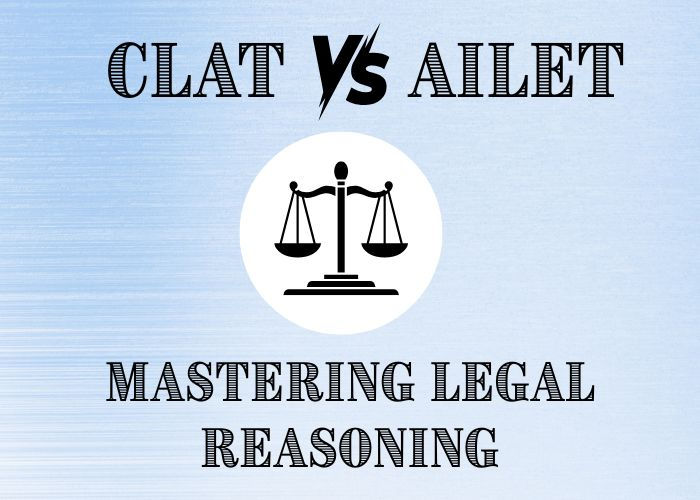Why AILET’s Legal Reasoning Needs a Different Strategy than CLAT
- kajal lawprep
- Aug 1
- 5 min read

When preparing for law entrance exams in India, most aspirants lump CLAT and AILET together. While both are gateways to prestigious law schools—NLU Delhi for AILET and 26 NLUs for CLAT—their question patterns differ significantly. Nowhere is this more evident than in the Legal Reasoning section. Understanding how and why AILET’s legal reasoning demands a different approach is crucial for any student attempting both exams.
Understanding Legal Reasoning in Both Exams
Before we talk about strategy, let’s clarify what the Legal Reasoning section is all about in both tests. In general, this section is meant to assess your ability to read legal passages and apply principles to factual situations.
1 . Legal Reasoning in CLAT
CLAT’s legal reasoning questions follow a passage-based format. Each question includes a 400-500 word passage discussing a legal principle, case law, or scenario, followed by a set of 4-6 questions. These passages focus more on comprehension and application than prior legal knowledge.
The CLAT Consortium emphasizes that students do not need prior legal knowledge and should rely only on the information provided in the passage. This makes CLAT’s legal reasoning more analytical and language-intensive.
2 . Legal Reasoning in AILET
AILET, on the other hand, does not strictly follow the comprehension model. Its legal reasoning is more direct, with principle-fact questions, and is often more knowledge-driven. Many questions are shorter but require quick application of legal maxims, constitutional values, and prior conceptual clarity. While AILET also doesn't assume legal knowledge, in practice, students benefit if they’ve been exposed to core legal principles already.
Key Differences in Legal Reasoning Between CLAT and AILET
Let’s break down the most important differences so you can plan your preparation accordingly:
1. Question Format
a . CLAT
Passage-based, analytical
b . AILET
Direct questions, factual scenarios
c . Implication
For CLAT, comprehension skills are a must. For AILET, speed and clarity in principle-application matter more.
2. Number of Questions
a . CLAT
35-39 legal reasoning questions, each tied to long passages.
b . AILET
Around 35 legal reasoning questions, mostly standalone.
c . Implication
In CLAT, one passage may take longer but covers many questions. In AILET, questions are dispersed but require quicker reading.
3. Role of Prior Legal Awareness
a . CLAT
Very little; focuses on reasoning using given info.
b . AILET
Some legal concepts like torts, contracts, and constitution help.
c . Implication
You might get an edge in AILET if you’ve done basic legal GK and principle theory in advance.
4. Time Management
a . CLAT
More time-consuming due to reading load.
b . AILET
Quicker to read, but accuracy is crucial due to tighter margins.
c . Implication
CLAT rewards patience; AILET rewards agility.
Check this also: What is the Best Time to Start Preparing for a Law Entrance Exam?
Why Your CLAT Strategy Won’t Work for AILET
Now that we’ve understood the structural differences, here’s why your CLAT-focused preparation will not be effective for AILET unless modified:
1 . Over-Reliance on Passage Reading
CLAT exam trains you to scan, interpret, and dissect legal passages. However, AILET wants quick application, not deep reading. Many students spend too long thinking like CLAT and end up running out of time in AILET.
2 . Lack of Principle Practice
CLAT often provides the principle in the passage. But AILET expects you to recall or apply common legal principles directly. So, if you’ve ignored learning basic tort, criminal, or constitutional principles, AILET will be a shock.
3 . Language vs Logic Focus
CLAT is slightly tilted towards language comprehension. AILET, however, tests logic-based legal reasoning. So, students with a humanities background who rely heavily on English proficiency might find themselves unprepared for AILET’s crisp, logic-heavy questions.
The AILET Legal Reasoning Strategy You Actually Need
Here’s how to specifically prepare for AILET’s legal reasoning section:
1. Master Core Legal Principles
Spend time on the basics of:
Law of Torts (negligence, strict liability)
Criminal Law (mens rea, actus reus, IPC sections)
Contract Law (offer, acceptance, breach)
Constitution (fundamental rights, directive principles)
These principles frequently show up in AILET. Make one-pagers of rules and case examples for quick recall.
2. Practice Direct Principle-Application Questions
Use resources like:
Universal’s Legal Reasoning
AILET-specific mocks
Previous year AILET papers Train your mind to go from principle → facts → judgment in 45-60 seconds.
3. Improve Speed + Accuracy
Unlike CLAT where one passage yields multiple questions, in AILET each question stands alone. So, set timers:
35 questions in 35 minutes
Build a rhythm of fast decision-making
Use elimination strategy when confused
4. Reinforce Legal GK (Optional but Helpful)
Even if AILET says prior knowledge isn’t needed, many toppers report that knowing the background of common laws helped them save time. Focus on:
Recent Supreme Court rulings
Key constitutional amendments
Landmark legal doctrines
Mid-Prep Advice for Dual Aspirants
Many students prepare for both CLAT and AILET simultaneously. If that’s you, here’s what you should do:
1. Dedicate Separate Practice Sessions
Don’t mix mocks. If today is CLAT, focus on passage-based legal sets. If tomorrow is AILET, go for direct principle-based questions. Train your brain to switch formats.
2. Make Two Legal Reasoning Notebooks
One for CLAT (passage-based summaries, logic notes)
One for AILET (short principles, key case laws, mini tests)
This will help reduce overlap and confusion.
3. Adjust Revision Style
In the last 2 weeks:
For CLAT: Read editorials and practice comprehension-based legal passages.
For AILET: Solve 2–3 full-length legal reasoning sets daily with a timer.
Common Mistakes to Avoid in AILET Legal Reasoning
1 . Skipping Practice Thinking “It’s Just Legal GK”
It’s not. You need legal logic.
2 . Using Only CLAT Material
AILET-specific mocks are essential.
3 . Spending Too Long Per Question
Aim for 1 min per question max.
3 . Neglecting Speed-Building
AILET rewards those who finish the section quickly and correctly.
Tools and Resources That Can Help
1 . Books:
Universal’s Guide to CLAT & LL.B.
A.P. Bhardwaj’s Legal Aptitude
LexisNexis Legal Reasoning Practice Papers
2 . Mock Test Providers:
LawPrep
LegalEdge
Career Launcher
If you're from northern India and looking for a structured approach to both CLAT and AILET legal reasoning sections, enrolling in a reputed program like CLAT Coaching in Lucknow could give you access to real-time feedback, mentorship, and AILET-specific mock drills.
Final Thoughts
Legal Reasoning is not one-size-fits-all. While CLAT and AILET both want to see your ability to think like a lawyer, they test this in drastically different ways. Ignoring this distinction is a mistake. AILET’s direct, time-sensitive, and principle-heavy approach means you need different tactics, different preparation material, and a different mindset.
Stay aware, stay adaptive, and most importantly—practice with purpose. That’s the only way to make legal reasoning your strongest weapon in AILET.



Comments